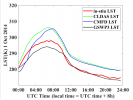Dear scinetist,
I have successfully replace the default GSWP3 forcing with my atm forcing (named CMFD, all of the seven forcing variable is with 3hr and 0.1° resolution) in clm5.0 and it works with the following three steps:
(1) Setup my case using GSWP3 forcing and modify files from there
(2) create a new domain file which is matched with atm forcing.
(3) modify the three stream files
However, the simulated dirunal cycle of LST ('TSKIN', 2004 average) of my study region is unreal (with an anomaly in UTC 10.30 am, see attached file1), while forced with GSWP3 is normal. I found it is the problem of FSDS ( solar radiation),see attached file2(model output FSDS). I think it may be caused by the reason that incoming solar radiation is not lined up with the cosine of the solar zenith angle in the model. I checked the origional CMFD solar, and make a comparsion with GSWP3 in 2004-07-28 and 2004-07-31 and found it is reasonable(see attached file3,4). The solar (including FSDS and FLDS) in CMFD is 3-hourly mean (from −1.5hr to +1.5hr) surface downward shortwave(longwave) radiation, while precipitation is 3-hourly mean (from −3.0hr to 0.0hr) precipitation rate.
I see the clm model needs to set the time axis from 00:00 UTC, so I write all of the seven forcing variables from 00:00 UTC and set all the offsets to zero, then an unexpected lst value has occurred in UTC 10:30 as I repoted above.
I see in clm user guide "Example of DATM stream files with your own forcing for 3-hourly data" , the offset of prec is set to -5400, while solar is -10800. So I change the offset value in user_datm.streams.txt.CLMGSWP3v1.Solar to -5400/-10800
However, when ./case.submit, it came wrong and shows :
(shr_strdata_advance) ERROR: dt limit1 0.25000000000000000 0.12500000000000000 1.5000000000000000
(shr_strdata_advance) ERROR: dt limit2 20040101 5400 20040101 16200
ERROR: (shr_strdata_advance) ERROR dt limit for stream
The datm_in of mine is as follows:
dtlimit = 1.5, 1.5, 1.5, 1.5, 1.5
fillalgo = "nn", "nn", "nn", "nn", "nn"
fillmask = "nomask", "nomask", "nomask", "nomask", "nomask"
fillread = "NOT_SET", "NOT_SET", "NOT_SET", "NOT_SET", "NOT_SET"
fillwrite = "NOT_SET", "NOT_SET", "NOT_SET", "NOT_SET", "NOT_SET"
mapalgo = "bilinear", "bilinear", "bilinear", "bilinear", "bilinear"
mapmask = "nomask", "nomask", "nomask", "nomask", "nomask"
mapread = "NOT_SET", "NOT_SET", "NOT_SET", "NOT_SET", "NOT_SET"
mapwrite = "NOT_SET", "NOT_SET", "NOT_SET", "NOT_SET", "NOT_SET"
readmode = "single", "single", "single", "single", "single"
streams = "datm.streams.txt.CLMGSWP3v1.Solar 2004 2004 2004",
"datm.streams.txt.CLMGSWP3v1.Precip 2004 2004 2004",
"datm.streams.txt.CLMGSWP3v1.TPQW 2004 2004 2004",
"datm.streams.txt.presaero.clim_2000 1 2000 2000",
"datm.streams.txt.topo.observed 1 1 1"
taxmode = "cycle", "cycle", "cycle", "cycle", "cycle"
tintalgo = "coszen", "nearest", "linear", "linear", "lower"
vectors = "null"
Anyboday know how to fix it out? Any suggestion or help is highly appreciated.
I have successfully replace the default GSWP3 forcing with my atm forcing (named CMFD, all of the seven forcing variable is with 3hr and 0.1° resolution) in clm5.0 and it works with the following three steps:
(1) Setup my case using GSWP3 forcing and modify files from there
(2) create a new domain file which is matched with atm forcing.
(3) modify the three stream files
However, the simulated dirunal cycle of LST ('TSKIN', 2004 average) of my study region is unreal (with an anomaly in UTC 10.30 am, see attached file1), while forced with GSWP3 is normal. I found it is the problem of FSDS ( solar radiation),see attached file2(model output FSDS). I think it may be caused by the reason that incoming solar radiation is not lined up with the cosine of the solar zenith angle in the model. I checked the origional CMFD solar, and make a comparsion with GSWP3 in 2004-07-28 and 2004-07-31 and found it is reasonable(see attached file3,4). The solar (including FSDS and FLDS) in CMFD is 3-hourly mean (from −1.5hr to +1.5hr) surface downward shortwave(longwave) radiation, while precipitation is 3-hourly mean (from −3.0hr to 0.0hr) precipitation rate.
I see the clm model needs to set the time axis from 00:00 UTC, so I write all of the seven forcing variables from 00:00 UTC and set all the offsets to zero, then an unexpected lst value has occurred in UTC 10:30 as I repoted above.
I see in clm user guide "Example of DATM stream files with your own forcing for 3-hourly data" , the offset of prec is set to -5400, while solar is -10800. So I change the offset value in user_datm.streams.txt.CLMGSWP3v1.Solar to -5400/-10800
However, when ./case.submit, it came wrong and shows :
(shr_strdata_advance) ERROR: dt limit1 0.25000000000000000 0.12500000000000000 1.5000000000000000
(shr_strdata_advance) ERROR: dt limit2 20040101 5400 20040101 16200
ERROR: (shr_strdata_advance) ERROR dt limit for stream
The datm_in of mine is as follows:
dtlimit = 1.5, 1.5, 1.5, 1.5, 1.5
fillalgo = "nn", "nn", "nn", "nn", "nn"
fillmask = "nomask", "nomask", "nomask", "nomask", "nomask"
fillread = "NOT_SET", "NOT_SET", "NOT_SET", "NOT_SET", "NOT_SET"
fillwrite = "NOT_SET", "NOT_SET", "NOT_SET", "NOT_SET", "NOT_SET"
mapalgo = "bilinear", "bilinear", "bilinear", "bilinear", "bilinear"
mapmask = "nomask", "nomask", "nomask", "nomask", "nomask"
mapread = "NOT_SET", "NOT_SET", "NOT_SET", "NOT_SET", "NOT_SET"
mapwrite = "NOT_SET", "NOT_SET", "NOT_SET", "NOT_SET", "NOT_SET"
readmode = "single", "single", "single", "single", "single"
streams = "datm.streams.txt.CLMGSWP3v1.Solar 2004 2004 2004",
"datm.streams.txt.CLMGSWP3v1.Precip 2004 2004 2004",
"datm.streams.txt.CLMGSWP3v1.TPQW 2004 2004 2004",
"datm.streams.txt.presaero.clim_2000 1 2000 2000",
"datm.streams.txt.topo.observed 1 1 1"
taxmode = "cycle", "cycle", "cycle", "cycle", "cycle"
tintalgo = "coszen", "nearest", "linear", "linear", "lower"
vectors = "null"
Anyboday know how to fix it out? Any suggestion or help is highly appreciated.










